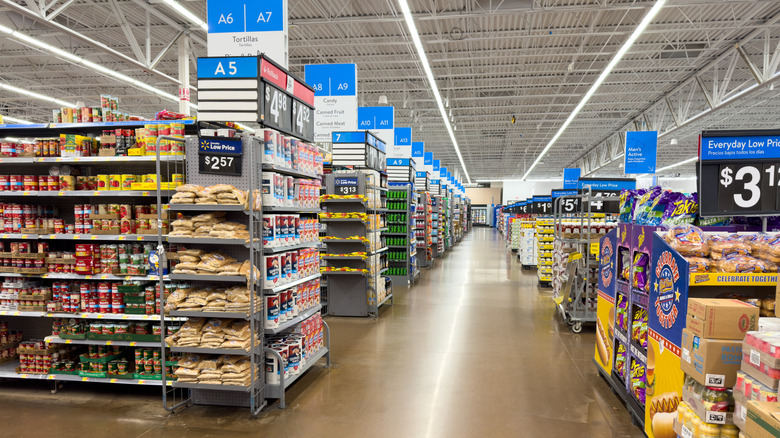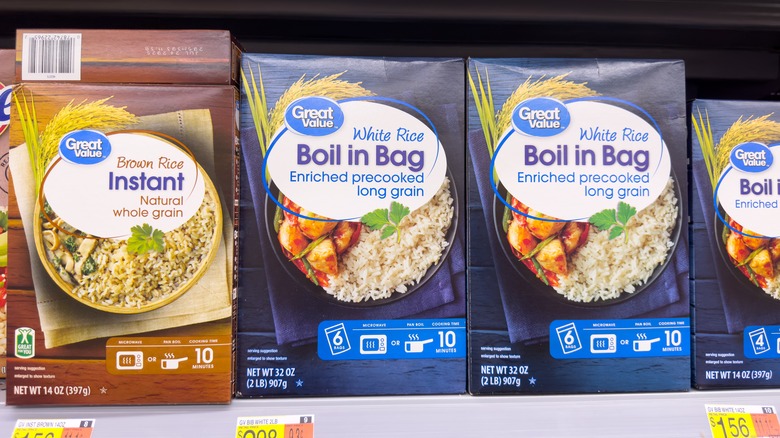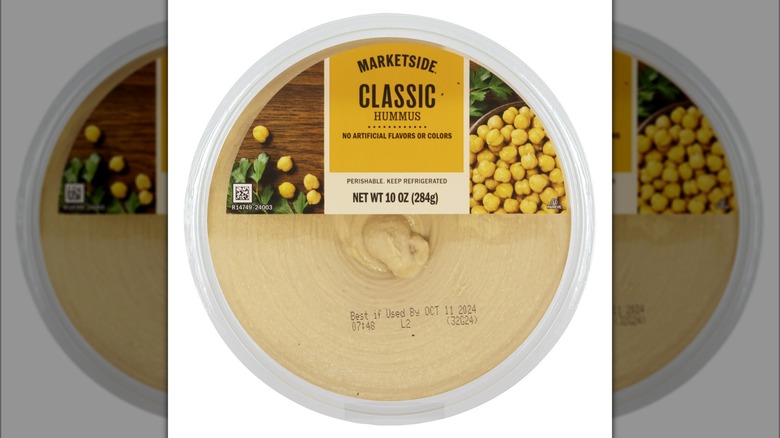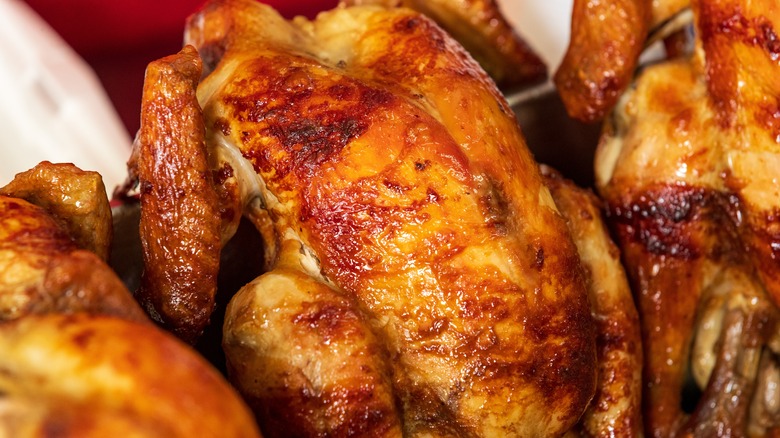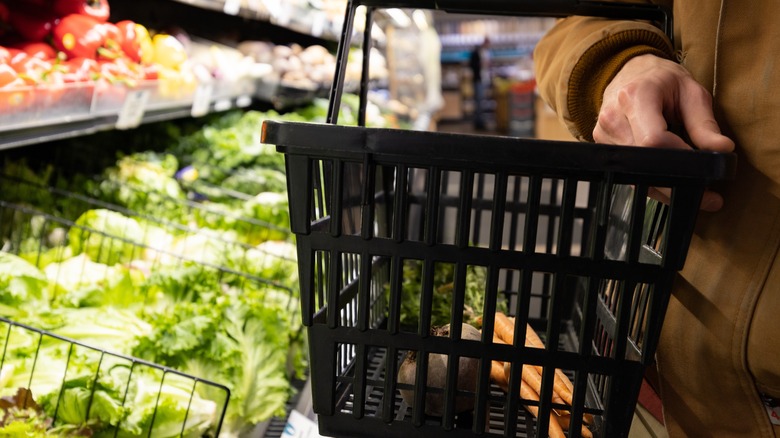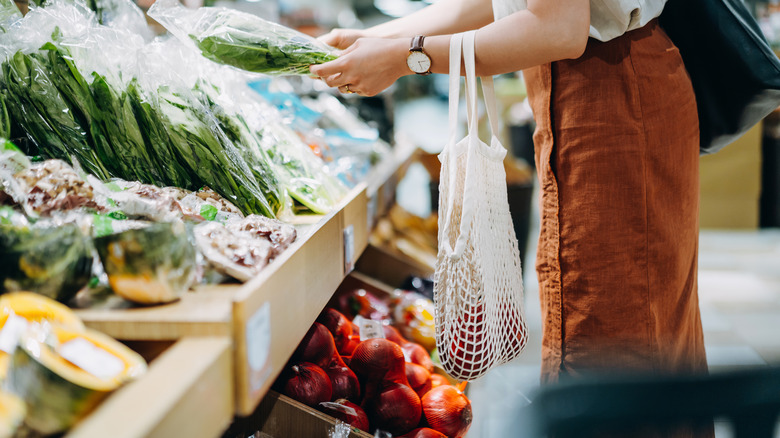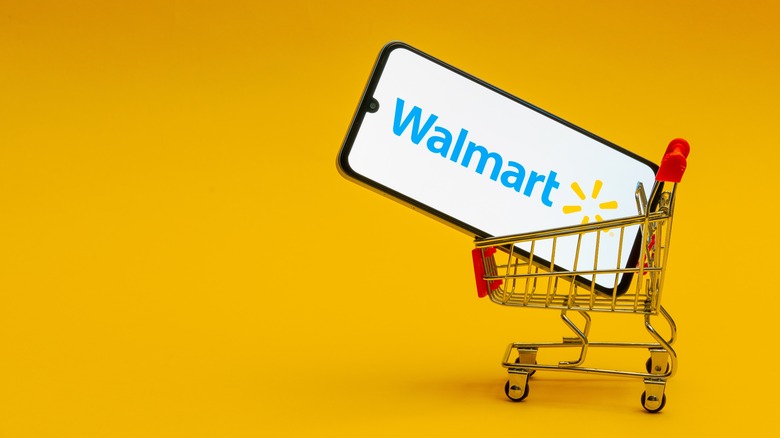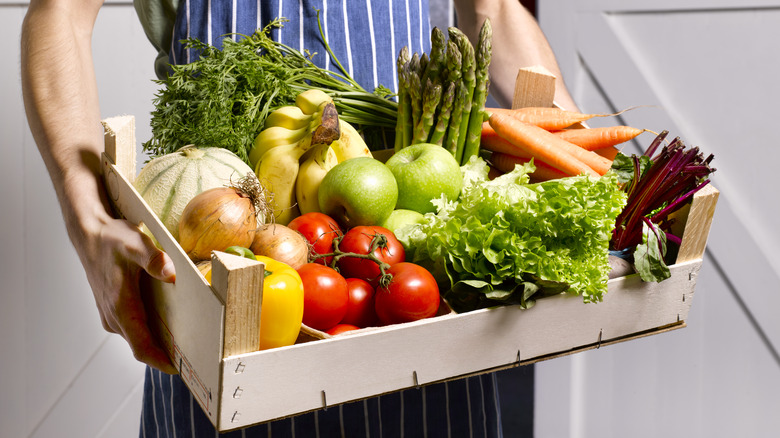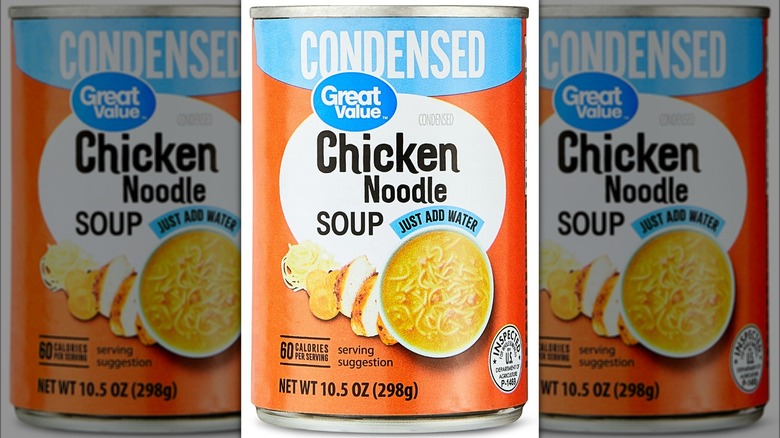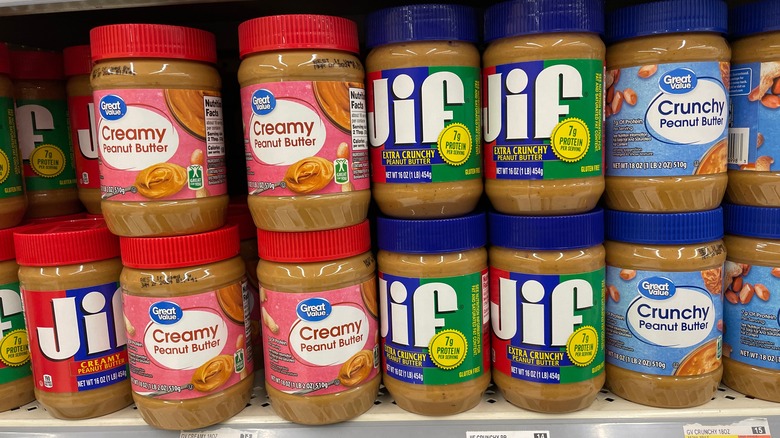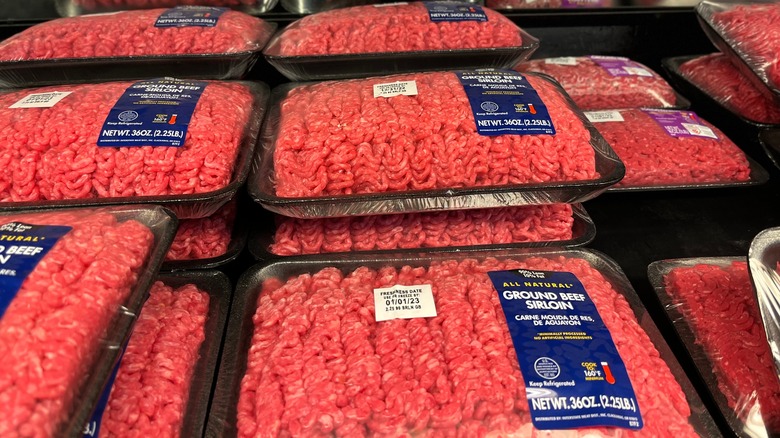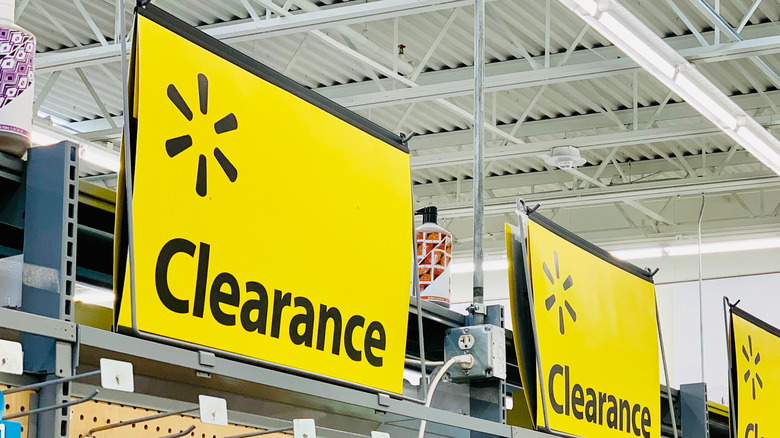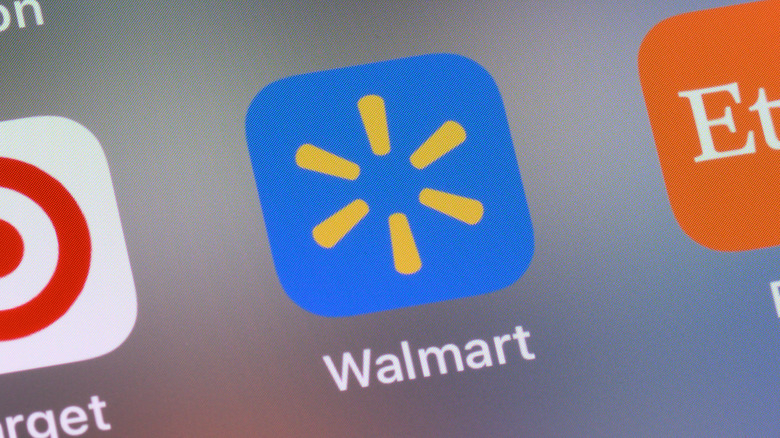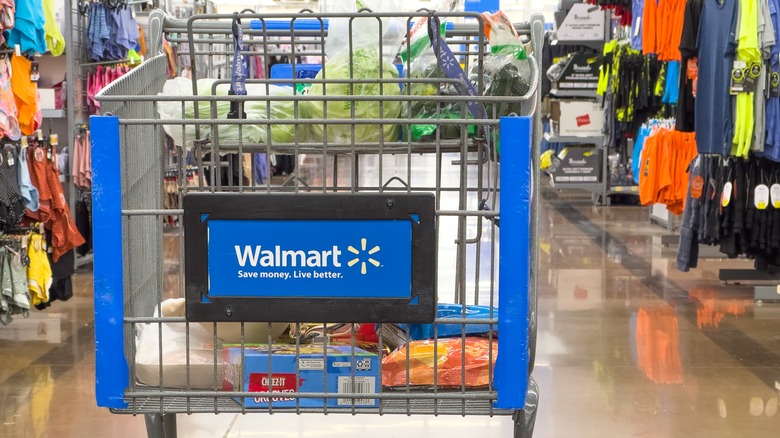14 Mistakes You're Probably Making When Buying Food At Walmart
We may receive a commission on purchases made from links.
If you've bought food at a major supermarket recently, it's pretty likely to have been Walmart. You don't need us to tell you how prominent the supermarket giant is: It's dominated the retail scene since the opening of its first store in 1962, and has since ballooned to over 4,600 individual locations. All those supermarkets carry a lot of grub — and because of the brand's ubiquity, you might feel like you've got buying food from there sussed out. Surprisingly, though, buying food from Walmart is a bit more confusing than you think, and if you're not careful you can walk away with a poor haul.
One of the main complications with buying food from Walmart is the sheer scope of its selection. With so many products in its stores, it's hard to know what's worth buying and what you should skip, and far too many people pick up the wrong items. Although Walmart is already pretty cheap, a lot of folks also forget to utilize Walmart's offers and spend more than they should. Its reasonable prices also lead people to forget to compare and contrast how much things cost, and assume that the store offers a better price than other places. Stop wasting your money, and check out all the mistakes you're likely making.
1. Mistake: Assuming that Great Value food is inferior in quality
Walmart has a few private labels, with a massive new private food label that was rolled out in early 2024. However, its Great Value line is its best-known private label, and Walmart goes big on its selection, stocking hundreds of Great Value food items in its stores. The combination of a wide selection and low prices has led people to assume that Great Value food is inferior quality than the name-brand items that Walmart stocks — but making this mistake leads a lot of people to pay above the odds. "Quality is often at least the same as the name brands or barely different," says smart shopping expert Trae Bodge of these items over on Go Banking Rates. "That is, you won't really notice, especially if they're not side by side."
Walmart Great Value items, and other own brand items from different stores, are often comparable not just in terms of taste, but in terms of ingredients and nutrition. When you pay for the more expensive items at Walmart, you're typically paying for a name or for better-looking packaging. That's not to say that certain items in the Great Value range won't be of lower quality, and that there are pricier alternatives that are noticeably better-tasting, but by and large the budget foods can be pretty good.
2. Mistake: Buying food online without checking its pickup discount
You can find pretty much anything you'd find in-store at Walmart on its website, making shopping online a breeze. However, don't forget to check whether you can make any extra savings when doing so. "When shopping online, be sure to check out whether or not an item has a pickup discount," advises smart shopping expert Trae Bodge. "Sometimes it can be on the smaller side, but sometimes these savings can be significant and well worth it to head to your local store, rather than relying on delivery."
Pickup discounts benefit both the customer and the store. The customer typically gets a set amount off their groceries, while the store doesn't have to factor in any shipping costs, saving them money and manpower. When going for a pickup discount, it's important to assess whether it is actually the best saving for you. If, for example, you anticipate that the cost of gas to get to the store will outweigh the cost of shipping, it may still be smarter to opt for delivery. Delivery may also be the best option if you're doing a massive grocery haul.
3. Mistake: Forgetting about its Marketside brand
There's always a lot of talk about Walmart's Great Value brand, but you shouldn't forget about its other product lines. Its Marketside brand is a private-label line that aims for a slightly more artisanal feel, and offers a host of ready-made foods that you should definitely be buying from Walmart. The Marketside brand specializes in deli and bakery goods, and items like its hummus and bread may have a fresher quality and taste than Great Value alternatives. Its hummus is especially loved by customers, who adore its creaminess and versatility.
One of the best things about Marketside's products is how reasonably priced they are. There is a fair price difference between Marketside items and Great Value ones — Great Value Macaroni and Cheese, for example, comes in at just over $1.50, while the Marketside version is a little under $3. However, the Marketside version is way bigger and has much better reviews, and it isn't super expensive either. In our opinion, it's worth paying that slightly higher price for a larger, tastier product.
4. Mistake: Buying your rotisserie chicken from Walmart
Walmart is designed to be a one-stop shop, but there are definitely some items that you shouldn't be buying from it. One of them is everyone's favorite deli item. Unfortunately, Walmart is renowned as one of the worst places to buy rotisserie chicken, and has been confirmed as such by a wide swathe of customers. In a survey conducted by Mashed on the quality of grocery store rotisserie chickens, over a third of the 582 participants rated Walmart's offering as the worst one out there. The next-worst option was voted as being from ShopRite, with a pretty wide margin between the two.
So what makes Walmart's rotisserie chicken so bad? Unfortunately, pretty much everything. Customers who have bought the chicken have noted that it has a tough, leathery flesh that likely comes from being overcooked. As well as this, it seems to have a pretty wild approach to its flavors, with a combination of over-salted meat and an under-seasoned flavor. Remember, seasoning isn't just salt, folks: Clearly, Walmart hasn't invested in its herbs and spices as much as it should have. Some people have even mentioned that their rotisserie chickens have been undercooked, which poses a massive health risk. Skip the deli section, and buy your chicken elsewhere.
5. Mistake: Neglecting to compare its food prices to other stores
Just because Walmart is cheap, doesn't mean it's the cheapest. There are plenty of supermarkets out there that offer similar or better value for your money than Walmart, and forgetting to compare the prices between two different stores can cause you to spend way more than you should. If it's just one or two items that are cheaper in other supermarkets, then it might not be worth heading elsewhere — but if most of your basket is cheaper, as it often is in a place like Aldi, then you should make a beeline for another store.
This is why it's worth taking advantage of price-comparison tools before you go shopping. Websites like Google Shopping give you the capacity to compare prices from multiple supermarkets. Alternatively, you can do the legwork yourself and pull up different supermarket websites, comparing item-by-item to calculate your final bill. Don't forget, too, to factor in variables like the size of each item, or how long it'll take you to get to each store — these will have an impact on the overall price of your trip and how much value for money your items represent.
6. Mistake: Purchasing all your produce from Walmart
The produce selection at Walmart is pretty abundant, and so it's tempting to grab everything you need with your regular grocery shop. If you want the best goods, though, you'd be better off avoiding its this section entirely. Walmart's produce can be notoriously hit-or-miss, and a lot of folks think that its quality is the worst out of all the major grocery stores. In a survey conducted by Mashed, over a third of the people asked said that Walmart had the worst produce, with the runner-up of Target getting less than half the votes that Walmart did.
This survey was corroborated by ratings given by members of Consumer Reports, many of whom confirmed that they think Walmart's produce is poor-quality. Where Walmart does earn points is in its wide selection of different types of produce, which can exceed a lot of other supermarkets. In our opinion, though, it's far better to head somewhere else to get your fresh goods. Central Market, Wegmans, Gelson's, and Publix all fare much better on the produce front — and if you want the absolute best quality items, heading to your local farmer's market will usually deliver the goods.
7. Mistake: Forgetting all the ways you can get savings on your food
Walmart understands how dog-eat-dog the grocery store market is (hey, your company doesn't get to be such a massive size without knowing how to beat the competition). To keep its customers walking through its doors, it offers a range of savings on top of its regular prices — and a lot of people forget about them. If you're flexible with the food you're buying, Walmart provides savings via its Flash Deals. These deals offer reduced-price items for a limited time, with the website handily showing how long they'll be on sale.
Additionally, if you're a regular Walmart shopper, you should probably be using Walmart+. Not only do you get a $20 coupon for referring a friend or loved one, but the membership program also has benefits like free delivery and Walmart Rewards, which can offer you further discounts. It's worth remembering that Walmart+ is a paid subscription service, so you'll have to work out if the price it costs will be worth it. If you're doing a weekly food shop online and paying for delivery each time, though, it may well be.
8. Mistake: Buying organic food from Walmart over other stores
Most of us would prefer to eat organic food over non-organic choices, but let's be real here: It's the price that puts us off. So buying it from a reasonably priced store like Walmart can feel like a smart choice — after all, when the cost is already pretty low, surely its organic food won't be much more expensive, right?
Wrong. Somewhat surprisingly, organic food at Walmart is outrageously expensive, and wildly more pricey than its non-organic items. If you were to replace all of your non-organic food options with organic ones at Walmart, you'd be paying 112% more than you normally would, according to an investigation performed by Consumers' Checkbook. For comparison's sake, if you did the same thing at Safeway, you'd only pay 33% more.
As well as this, a full cart of organic goods at Walmart is way more expensive than at pretty much any other store out there. Instead of being caught out, get wise to where you go. Shopping at Aldi, Trader Joe's, and Amazon Fresh are all great ways to keep your food bill down while still getting some good organic grub.
9. Mistake: Opting for its store-brand canned soups
Walmart has a huge range of store-brand canned soups in its Great Value lineup. Unfortunately, though, you should avoid them if you want your food shop to remain healthy. "Walmart's store-brand canned soups can be loaded with sodium and artificial additives," explains registered dietitian Trista Best to All Recipes. Its Great Value Chicken Noodle Condensed Soup, for example, has 890 milligrams of sodium per serving, almost 40% of your daily value. It's also packed with ingredients like modified corn starch and mechanically separated chicken meat, which don't exactly sound appetizing.
Having said all this, you can still make healthy choices with its store-brand canned soups. Certain Great Value soups have a healthy version, which have a reduced sodium content. Unfortunately, these soups often have the same artificial or mechanically-processed ingredients, so you don't get much of a change there. If you want things to be both low-sodium and made with good-quality ingredients, it's likely worth going for a slightly pricier brand for your soup at Walmart, like Pacific Foods or Amy's Organic.
10. Mistake: Buying its Great Value peanut butter over other brands
While a lot of Walmart Great Value foods hit the mark, others are a real waste of your money. One of them is Great Value Creamy Peanut Butter. This peanut butter has a notoriously poor texture, with taste-testers and customers alike finding that it's difficult to spread, with a thick, almost chalky consistency. Its flavor doesn't win any awards either, with the nut butter having an unbalanced flavor profile of overt sweetness and a slightly burnt undertone.
It's also worth remembering that Great Value Creamy Peanut Butter is imbued with vegetable oil and sweeteners (which gives it that sugary taste), taking it from a foodstuff that could be potentially wholesome to one that's overly-processed. Although it's definitely not the worst peanut butter out there, with taste-testers finding that Kroger's and Whole Foods' options represent poorer value for money overall, you'd be better off getting your peanut butter from another supplier. Paying a few extra bucks to get an organic option could leave you with something way less processed, and way more tasty. You'll also be able to avoid the product that was behind one of the food recalls that will always haunt Walmart.
11. Mistake: Buying ground beef at Walmart
Walmart doesn't always offer you the value for money that you think it will have on its items. One key kitchen staple, the humble pack of ground beef, is a particularly poor purchase. Buying ground beef at Walmart is a mistake because it's actually surprisingly pricey compared to other stores, especially when you take quality into account. Beef is not only way cheaper at Aldi, but it's also considered to be of similar or better quality as at the retail giant. You'll also pay a similar price for your ground beef at Costco, for what's widely considered to be a superior product.
As such, next time you head to Walmart, you'd be wise to leave the ground beef on the shelf. Don't be fooled into thinking that its pricier options will give you a better result, either. Its Marketside Organic Grass-Fed Ground Beef sounds like a winner, until you check out some of its reviews and see that customers have lamented its gristly, tough texture and lack of flavor. We think we'll shop elsewhere for our beef, thanks.
12. Mistake: Not checking the grocery clearance aisle
Like most supermarkets, Walmart has an aisle devoted to clearance items — and if you're not checking it when you visit, you're missing out on some treasures. These aisles are full of juicy offers on foods that are nearing their sell-by date or have been slightly damaged in some way, but are still perfectly edible. This is especially true of shelf-stable items like crackers or canned goods that might have a little cosmetic damage, but will be totally fine to eat.
It's worth remembering that not all clearance items will be placed in the clearance section. Some reduced items will be dotted around the store, demarcated by a yellow sticker that shows their new price. It's therefore worth keeping a keen eye out as you're purchasing your normal goods, as you may well be able to find reduced items in the fridge or freezer sections that could save you a good few dollars. These reduced foods are especially good to pick up if you need to stock up your freezer: By stashing them in your deep freeze, you don't need to worry about eating them immediately.
13. Mistake: Forgetting to use the app
Every business out there has an app these days, and Walmart is no exception. Its mobile app is a must-get for regular food shoppers, thanks to its nifty features and ability to help you find some great savings. As well as allowing you to look up the price of food items in your local store and add them to an in-app shopping list, the Walmart app also has a super-handy map function that shows you the floor plan of your supermarket. If you've ever spent 10 minutes traipsing up and down the aisles to find a specific item (hey, no judgment, we do that literally every time we go shopping), this feature is a total time-saver.
The Walmart app also allows you to take advantage of manufacturer offers. This feature lets you grab a discount on hundreds of different items in-store, and when you buy them you're rewarded with Walmart Cash. Walmart Cash can then be put towards a further discount on future purchases or shops, or you can claim cashback from it to spend elsewhere. Pretty neat, huh?
14. Mistake: Shopping at the wrong time of day
Okay, we get it. Not everyone's an early riser (ourselves included). However, if you can bring yourself to set that alarm and get to Walmart bright and early, you might be in for a better shopping experience. Heading to the store when it opens gives you the best chance of getting the best produce, thanks to its restocking schedule — and it's a particularly wise move if you're buying perishable items. "Walmart staff often restocks these items overnight," explains BrickSeek's head of public relations and content director Bethany Hollars via EatingWell. "So you'll have a better chance of finding the freshest selections shortly after the store opens."
Importantly, if you can't make it to the store first thing in the morning, there's no need to worry. Most supermarkets restock their items regularly throughout the day, to ensure that you're always able to get what you need (well, most of it, anyway). Having said that, it's usually worth trying to get to the store before busy periods like the after-work rush, as you'll have the pick of the litter when it comes to produce and won't be left with the worst-looking items.
Static Media owns and operates Daily Meal and Mashed.
